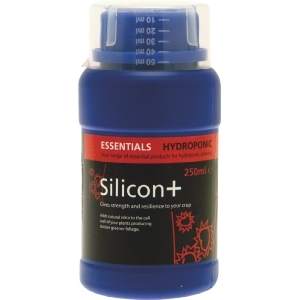Silicon and Tomato Plants
The benefits of using soluble silicon as a supplement are many but it is rarely mentioned in gardening circles.

It is only recently that research has started to show the benefits of silicon in the garden because there is still a lot about the way plants use nutrients that science has yet to discover.
We can fly to the moon in a space ship but there is a lot going on in our gardens that the most advanced scientific research has yet to uncover.
For years there has been a difference of opinion with regard to the value of giving silicon as a supplement to plants and whether or not it should be treated as a macro or micro nutrient.
It seems that those who have always said no, are re-evaluate their views because of the findings of recent research.
The Benefits of Silicon for Tomato Plants
These benefits include greater tolerance of environmental stresses, such as cold, heat, drought, salinity, mineral toxicity or deficiency.
Improved growth rates and resistance to insects and fungi. Soluble silicon promotes natural fungal defence mechanisms in plants, significantly reducing and, in many cases eliminating entirely, the need to use fungicides.
Silicon deposited in epidermal cell walls makes plants resistant to small sucking insects. The resulting increased mechanical strength in epidermal cell walls enhances leaf presentation and stem strength.
Soluble silicon enhances metabolic functions and improves pollen fertility, fruit and flower count.
The information above is taken from the following:
http://www.simplyhydro.com/benifits_of_silicone.htm
So, is it worth adding silicon to our tomato feed?
This is my first season using a soluble silicon supplement and I’ve been applying it as a foliar spray.
I’ll let you know the results later in the season, but I think that if it is only half as effective as the benefits above suggest, it is well worth a try – in a Summer like this, we need all the help we can get!


Terry Cooney
Hi Nick,
I have thick green growth this year. I have to cut back a lot leaf to get air in.
In reducing the leaf will I be cutting down the Sugar supply to the Tomatoes?
(Beefsteaks are in clusters of four and about 1.5 and 3/4inches size.)
A friend of ours has used seaweed for a number of years. Collects it in November drapes over a wall all winter ( It’s the long strip type) Then digs in-chops with sharp spade, 6 inches
below clay surface. This is for both Potatoes and Tomatoes. Good results.
Regards, Terry.
Mark D
I used to live in Cornwall and tried using bulk seaweed from the beach a few times. I added it to the compost heap and also trenched some for runner beans. But I never tried it with tomatoes particularly.
I don’t remember my results being particularly good or bad. But it did pong a bit as it was breaking down!
Rhys Jaggar
Douglas
I can tell you that tomatoes love the soluble seaweed extract that you can buy in garden centres. I’ve used it as a foliar spray this season and the results have been excellent. I don’t know how they make it, but if you can find a way to do it, I’d certainly recommend it!
One thing though: when the weather gets warmer, you may find that little things start growing in the diluted extract in your spray canister. My first canister in April/early May had no problems, but the second one I had to ditch half way through and sterilise the canister using detergent.
douglas
Hi Nick,
Ive got a feeling this might be a silly question….But Ill ask it anyway. I live quite near the coast and there is quite a lot of seaweed washed up,my question is,is it worth collecting some for tomato feeding,and if so how would I apply it to the plants? ..and of course in qwhat quantity?
regards
Nick
Hi Douglas,
The main thing to remember is to run it under the tap to remove as much salt as possible – tomato plants don’t like salt!
Here’s a link to a Youtube video that is interesting but does have some background noise.
http://youtu.be/_qbTeb-7NHg?hd=1
Regards,
Nick